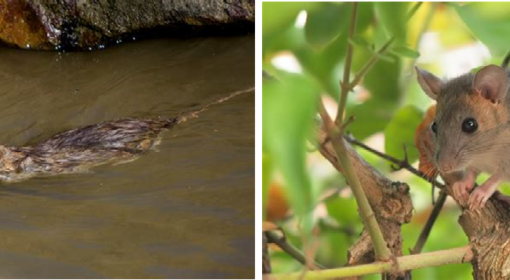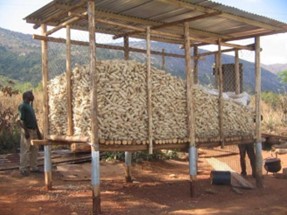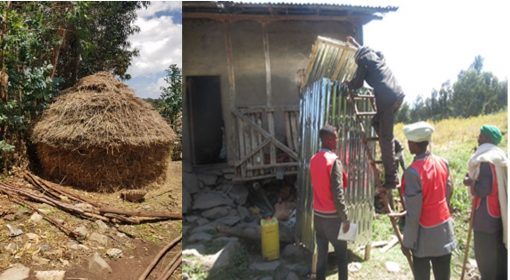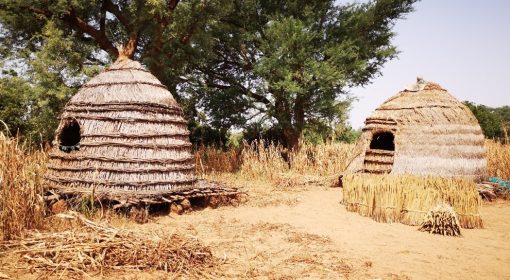Interested in this topic? Join our webinar on the occasion of the International Day of Biodiversity on 22 May 2024. Read more about this webinar and sign up here.
By: Luwieke Bosma (MetaMeta Research) and Yonas Meheretu (Swedish University of Agricultural Sciences, SLU)
1. Biodiversity at the ecosystem level
From the viewpoint of those engaged in sciences such as population biology, ecology, ecosystems, evolution, and genetics, biodiversity has a specific meaning: “the variety and variability of biological organisms’ (NASE, 1999). Although this is a rather broad definition, its clarity can be enhanced by examining various levels of biological organisation ranging from genes, species, and communities to ecosystems and even the entire planet.
Ecologically-Based Rodent Management (EBRM) is based on a thorough knowledge of rodents’ ecological requirements. From there, it deploys methods that are foremost focused on preventing populations from growing beyond measure through a range of eco-friendly actions. To understand better how EBRM relates to biodiversity, we will focus on the ecosystem level. Ecosystems represent a complex interplay of living organisms within their physical environment comprising all the elaborate relationships in a particular space unit. This encompassing concept includes factors like climate, soil and water for instance, and all its living members. The size we look at is that of an entire landscape.
Particularly in Ethiopia, the highland and afro-alpine ecosystems are rich in endemic species but also vulnerable. These ecosystems face several challenges, including climate change, expansion of agriculture, and human settlements, affecting unique habitats, thus leading to shifts in species distribution, and the loss of endemic plant and animal species. These shifts signal not only alterations in the composition of species but also a profound transformation in the complex web of interdependencies that sustains these ecosystems.
2. Rats and biodiversity – where does it go wrong?
Invasive rats: Explorers and disturbers of new ecosystems
Like human adventurers traversing distant seas, rats have traveled the seven seas and been explorers of new lands. And just like humans, they often stayed in that new land and settled, becoming an invasive species (also called alien or exotic species). An invasive species, by definition, is any nonnative species that significantly modifies or disrupts the ecosystems it invades. Among the most prevalent and invasive rat species are the black or roof rat (Rattus rattus), the brown or Norway rat (R. norvegicus), and the Pacific rat (R. exulans). These rats have established themselves across a wide range of habitats. When introduced to islands, rats invariably disrupt ecosystem connections, significantly affecting species evolved in predator-free environments. The consequences of these rat invasions have proven dire, resulting in the extinction or significant population declines of various native species (Harper et al., 2015).
Rats become invasive due to their competitive edge over native species, thriving particularly in ecosystems devoid of natural predators. Over time, these invaders can supplant indigenous species through predation, depleting their numbers, or seizing their food sources. Adding to the complexity, invasive rats amplify the spread of diseases by acting as vectors for parasites and pathogens, further unsettling the ecosystem. This phenomenon is starkly evident in unique island ecosystems, although the influence of rats extends universally. Rats further wreak havoc on ecosystem dynamics by preying on animals and plants, triggering cascading effects that lead to collapse. They disrupt critical processes like pollination, nutrient cycles, and seed predation, sometimes culminating in the collapse of entire forests.
Invasive mammalian predators imperil 596 species teetering on the brink of extinction. Among these, cats, rodents, dogs, and pigs emerge as the most menacing, posing threats to many species. Specifically, rodents have been implicated in the demise of 75 species. This distressing toll includes 52 bird species, 21 mammal species, and two reptile species, collectively accounting for a staggering 30% of all extinctions attributed to invasive predators (Doherty et al., 2016).
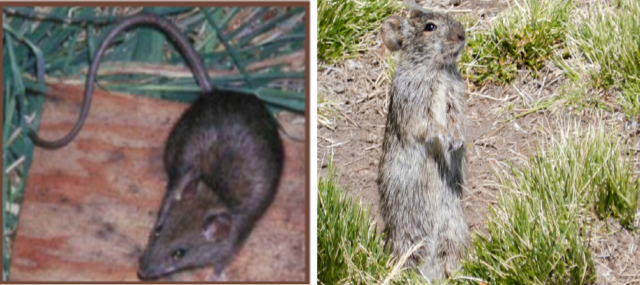
Rodents, as masters of prolific reproduction, are an agricultural menace.
Characterised by their impressive reproductive capacities, Rodents can synchronise their breeding cycles with the ebb and flow of food availability. Rodents, such as rats and mice, have the ability to rapidly reproduce when they have access to abundant food and shelter. This reproductive cycle can be closely linked to hydrological cycles and environmental conditions, such as heightened rainfall anomalies. Rodent pests can cause extensive damage to agriculture by consuming crops and contaminating food stores. The destruction of crops and food reserves not only translates to financial setbacks for farmers but also jeopardises the stability of food security. Furthermore, these rodents serve as vectors for over 60 diseases that can afflict humans and animals, posing a severe threat to public health.
Rodents can disrupt ecosystems by outcompeting other species for resources. Farming systems often lack natural predators that generally keep rodent populations in check. When habitats are altered for agriculture, the natural predators of rodents, such as raptors, owls, snakes, and mongoose, may see their populations decline due to reduced habitat options. This reduction in predator numbers creates a favourable environment for rodents.
The unchecked proliferation of rodents disrupts the equilibrium of ecosystems and agricultural systems. Addressing this challenge necessitates exploring strategies to restore the equilibrium, including innovative approaches to sustaining natural predator populations and implementing sustainable farming practices. Only through a comprehensive and harmonised effort can the complex web of relationships within ecosystems be restored, ensuring the survival of diverse species and safeguarding the delicate balance of our environment.
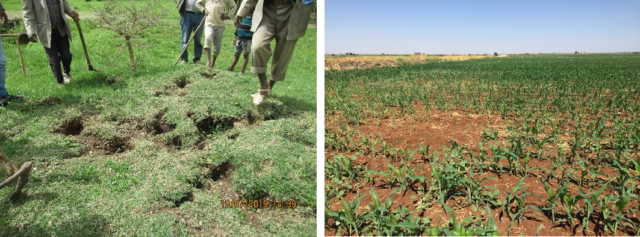
Climate change adaptability
Rodents display superior adaptability to climate change. Therefore, climate change is expected to exacerbate the issue of pest rodents, particularly in response to shifts in vegetation patterns prompted by alterations in precipitation patterns, granting them an edge over other mammalian species (Kholoud et al., 2020). Concurrently, predator populations for these rodents are projected to decrease, amplifying the complexity of this issue (Cameron & Scheel, 2001; Mougeot et al., 2019).
A Moroccan case: Climate vs. disease dynamics. In Morocco, a compelling case study highlights the profound influence of climatic conditions on the proliferation of zoonotic disease. Zoonotic cutaneous Leishmaniasis (ZCL), linked to Leishmania major, is intricately linked to Phlebotomus papatasi, a sandfly with a broad distribution in the country, albeit constrained by specific physiological prerequisites. These prerequisites result in concentrated populations, primarily found in the southern high Atlas region, a habitat conducive to the thriving of Meriones shawi, a rodent acting as a reservoir for the disease. Subtle fluctuations in surface climate conditions can reverberate throughout the ecosystem, impacting vector density and activity and potentially triggering disease outbreaks.
Emerging research suggests that modifications in surface climatic conditions might have set off a trophic cascade, leading to a surge in ZCL cases attributed to L. major. The hypothesis centres on the increased precipitation witnessed over the past decade, fostering local vegetation growth that, in turn, provides augmented food and shelter for both the rodents, acting as L. major reservoirs, and the sandflies responsible for disease transmission. Notably, the escalating minimum temperatures, which enable higher sand fly larvae survival rates during winters, might have established conditions conducive for endemic ZCL in the pre-Saharan regions of Morocco, where such conditions were previously absent (Karmaoui et al., 2021).
Rodents as catalysts. The overall imbalance created by the rapid proliferation of rodents can have cascading effects on ecosystems:
- Biodiversity loss: Rodent population explosions can lead to declines in other species that they outcompete for resources. This can disrupt food chains and cause biodiversity loss, potentially leading to the extinction of certain animal species.
- Disease transmission: The abundance of rodents can be a vector for various diseases, which can be transmitted to humans, livestock, and other animals. This poses a significant public health risk, while also entailing economic implications.
- Habitat alteration: The ecosystem disruptions caused by rodents can alter habitats, affecting the availability of resources for other species and potentially leading to habitat degradation.
3. What are the positive contributions of rodents to ecosystems and biodiversity?
While the negative impacts of rodents on ecosystems and biodiversity are well-documented, it is essential to acknowledge that rats and mice can also play a positive role in shaping their environments.
- Soil enhancement through burrowing: Burrowing rats and mice species serve as unwitting gardeners of the underground world. As they create burrow systems, their excavation activities contribute to improved soil aeration (Davidson et al., 2013). Enhanced soil aeration is vital for plant root health and overall soil quality. By facilitating better air circulation, rodents indirectly aid in the growth of plants and the overall vitality of the ecosystem.
- Accelerating organic matter decomposition: Rats and mice tend to hoard plant residues and store them within their burrows. This behavior has profound ecological implications as the plant materials stored by rodents undergo an accelerated decomposition process underground (Lavelle et al., 2006). This fast decomposition process enriches the soil with valuable organic matter, releasing essential nutrients for plant growth (Kramer et al., 2012). This benefits wild vegetation and crops by improving soil health and boosting crop production. Furthermore, this enhanced soil health supports diverse communities of microorganisms and invertebrates, fostering biodiversity in the ecosystem (Bardgett & van der Putten, 2014).
- Role as prey: Rodents occupy a significant place in the food web as prey for predators, including raptors, owls, snakes, and carnivorous mammals (Gosselin et al., 2006). Their presence provides sustenance for these higher trophic level species, contributing to the stability and biodiversity of ecosystems.
- Insect and weed Control: Rodents, particularly mice, consume various insects and weed seeds (Batzli, 1977). This herbivore and insectivore behavior can help regulate insect populations and limit the spread of weeds, offering a natural form of pest control.
In summary, while rodents, mainly rats and mice, are often viewed as pests due to their detrimental effects, they can serve as inadvertent stewards of ecosystem health through soil enhancement, support of predator populations, and natural pest control mechanisms. Understanding the complex role of rodents in ecosystems can aid in developing more holistic pest management strategies that consider both their negative and positive impacts.
4. Enhancing Biodiversity with EBRM
Addressing the complex issue of rodent management in a way that promotes biodiversity and ecological balance requires a multi-faceted approach that integrates both ecological and agricultural strategies. As conventional pest management often relies heavily on chemical rodenticides, which can have detrimental effects on non-target species and the environment, EBRM takes a different approach by emphasising non-chemical methods of rodent control, reducing the negative ecological impact of pest management efforts (Lehotay et al., 2018). Let us explore how EBRM can help improve biodiversity and ecosystem health while mitigating the negative impacts of rodent populations.
EBRM places a strong emphasis on understanding the ecological requirements of rodent populations. By comprehensively assessing the environmental conditions that favor rodent expansion, EBRM aims to prevent population surges by managing the local environment effectively (Singleton et al., 2007). In this, EBRM employs a two-fold strategy—prevention and control. The prevention phase focuses on creating an environment where rodent populations cannot thrive. This involves controlling access to food and water, reducing shelter options, and preventing migration. In case of infestations, the control phase comes into play and employs natural enemies, mechanical measures, and bio-rodenticides to reduce rodent populations (Singleton et al., 2005).
An example of prevention is adopting sustainable farming practices that discourage rodent infestations. This includes practices like crop rotation, proper storage of food, and habitat management. As such, farmers create an environment less conducive to rodent proliferation (Eggleton et al., 2011).
One of the core principles of EBRM is the promotion and enhancement of natural predator populations. Predators such as raptors, owls, snakes, and carnivorous mammals can help regulate rodent numbers naturally (Barton et al., 2018). Maintaining healthy predator populations creates a balanced ecosystem where rodents are controlled without resorting to chemical rodenticides.

With this approach, EBRM contributes to improved food security by reducing the direct threat rodents pose to pre- and post-harvest activities. Rodents are responsible for significant crop damage, and EBRM can help cut losses by as much as 50% (Singleton et al., 2005). Moreover, by limiting disease spread and contamination caused by rodents, EBRM also enhances the health conditions of people and livestock (Ghosh et al., 2019). In essence, EBRM offers a holistic and ecologically sensitive approach to rodent management that addresses the challenges posed by rodents, fosters biodiversity, promotes sustainable farming, and contributes to overall ecosystem health.
Lastly, we are continuously investigating the intricate connections between EBRM and biodiversity conservation within sustainable ecosystems. A few central themes include
- interdependencies between rodents and other species concerning the restoration of critical habitats,
- possible synergies in regenerative agriculture practices with EBRM and its impact on ecosystem dynamics and
- climate change mitigation.
We invite you to share your knowledge and experiences to help further unlock innovative and holistic pest management practices that safeguard agricultural productivity and the health of our planet’s diverse ecosystems. Reach out to Luwieke Bosma via lbosma@metameta.nl
References:
Bardgett, R. D., & van der Putten, W. H. (2014). Belowground biodiversity and ecosystem functioning. Nature, 515(7528), 505-511.
Barton, K. E., & Lindhjem, C. E. (2018). Predators indirectly reduce the prevalence of an insect-vectored plant pathogen independent of predator diversity. Ecology Letters, 21(8), 1169-1177.
Batzli, G. O. (1977). Food habits of prairie voles (Microtus ochrogaster) in southern Illinois. Journal of Mammalogy, 58(1), 62-69.
Cameron, G.N., Scheel, D., 2001. Getting warmer: Effect of global climate change on distribution of rodents in Texas. Journal of Mammalogy 82, 652–680. https://doi.org/10.1644/1545-1542(2001)082<0652:GWEOGC>2.0.CO;2
Davidson, A. D., Detling, J. K., & Brown, J. H. (2013). Ecological roles and conservation challenges of social, burrowing, herbivorous mammals in the world’s grasslands. Frontiers in Ecology and the Environment, 11(3), 158–166.
Tim S. Doherty, Alistair S. Glen, Dale G. Nimmo, and Chris R. Dickman (2016). Invasive predators and global biodiversity loss.Edited by Daniel S. Simberloff, The University of Tennessee, Knoxville, TN, and approved July 20, 2016 (received for review February 12, 2016). September 16, 2016, 113 (40) 11261–11265, https://doi.org/10.1073/pnas.1602480113
Eggleton, P., Clutton-Brock, T. H., & Dalerum, F. (2011). Rodent predation in an African acacia tree: the role of extrafloral nectar and associated arthropods. Biotropica, 43(3), 340-346.
Ghosh, S., Kakati, S., & Buragohain, R. (2019). Impact of rodents on agriculture and food security: A review. Global Journal of Environmental Science and Management, 5(4), 439-450.
Gosselin, M., Lechowicz, M. J., & Visser, S. (2006). The ecological roles of water in the life history of rodents. Oikos, 113(2), 325-333.
Grant A. Harper, Nancy Bunbury, Invasive rats on tropical islands: Their population biology and impacts on native species, Global Ecology and Conservation, Volume 3, 2015, Pages 607–627, ISSN 2351-9894, https://doi.org/10.1016/j.gecco.2015.02.010
Karmaoui, A., El Qorchi, F., Hajji, L. et al. Eco-epidemiological aspects of Zoonotic cutaneous leishmaniasis in Ouarzazate Province, Morocco. J Parasit Dis 45, 341–350 (2021). https://doi.org/10.1007/s12639-021-01368-z
Kholoud, K., Bounoua, L., Sereno, D., Hidan, M. El, Messouli, M., 2020. Emerging and re-emerging leishmaniases in the Mediterranean area: What can be learned from a retrospective review analysis of the situation in Morocco from 1990 to 2010? Microorganisms 8, 1–11. https://doi.org/10.3390/microorganisms8101511
Kramer, S. B., Reganold, J. P., Glover, J. D., Bohannan, B. J., & Mooney, H. A. (2012). Reduced nitrate leaching and enhanced denitrifier activity and efficiency in organically fertilised soils. Proceedings of the National Academy of Sciences, 109(12), 5437–5442.
Lavelle, P., Decaëns, T., Aubert, M., Barot, S., Blouin, M., Bureau, F., … & Rossi, J. P. (2006). Soil invertebrates and ecosystem services. European Journal of Soil Biology, 42, S3-S15.
Lehotay, S. J., Taylor, J. K., & Bobrinskaya, O. (2018). Fumigation of rice with sulfuryl fluoride for control of stored-product insects and acarids. Journal of Stored Products Research, 77, 152-159.
Mougeot, F., Lambin, X., Rodríguez-Pastor, R., Romairone, J., Luque-Larena, J.J., 2019. Numerical response of a mammalian specialist predator to multiple prey dynamics in Mediterranean farmlands. Ecology 100. https://doi.org/10.1002/ecy.2776
National Academies of Sciences, Engineering, and Medicine (NASE). 1999. What is Biodiversity? Perspectives on Biodiversity: Valuing Its Role in an Ever Changing World. Washington, DC: The National Academies Press. https://doi.org/10.17226/9589.
Singleton, G. R., Brown, P. R., Jacob, J., Aplin, K. P., & Krebs, C. J. (2005). Impacts of rodent outbreaks on food security in Asia. Wildlife Research, 32(6), 421-427.
Singleton, G. R., Petch, D. A., & Brown, P. R. (2007). Rodent outbreaks in Southeast Asia. In Proceedings of the Eleventh Wildlife Damage Management Conference (pp. 181–187).
